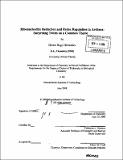Ribonucleotide reduction and redox regulation in Archaea : surprising twists on a common theme
Author(s)
Hernandez, Hector Hugo
DownloadFull printable version (77.31Mb)
Other Contributors
Massachusetts Institute of Technology. Dept. of Chemistry.
Advisor
Catherine L. Drennan.
Terms of use
Metadata
Show full item recordAbstract
To study the nucleotide reduction system in Archaea, we have expressed the Archaeoglobus fulgidus gene encoding the adenosylcobalamin (AdoCbl) dependent ribonucleotide reductase (afuRNR) protein. Initial characterization of the recombinant afuRNR indicates that it reduces CDP to dCDP in an AdoCbl dependent manner. One astonishing finding is the capacity of afuRNR to reduce both diphosphate and triphosphate nucleosides to their respective deoxynucleosides. This is the first instance of a RNR displaying dual substrate selectivity. Our investigation of redox regulation focused on thioredoxin reductase (TrR) and thioredoxin (Tr). In addition to providing the reducing equivalents for many RNRs, TrRs are involved in maintaining the intracellular redox environment. This process typically involves the transfer of electrons from NADPH to Trs. Here the characterization of a putative TrR (Ta0984) and Tr (Ta0866) from Thermoplasma acidophilum are presented. To explore the apparent inability of taTrR to use NADPH or NADH as a reductant, we carried out a complete electrochemical characterization, which ruled out redox potential as the source of this non-reactivity. A 2.35 A resolution structure of taTrR, also presented here, shows that despite the overall structural similarity to the wellcharacterized TrR from E. coli, the "NADPH binding pocket" is not conserved. E. coli TrR residues implicated in NADPH binding, H175, R176, R177, and R181 have been substituted with E185, M186, Y187, and M191 in the ta protein. Thus, we have identified a Tr and TrR protein system from T. acidophilum for which the TrR shares overall structural and redox properties with other TrRs, but lacks the appropriate binding motif to use the standard NADPH reductant. Our discovery of a TrR that does not use NADPH provides a new twist in redox regulation.Further, four A. fulgidus genes encoding four Trs (afuTr 1, afuTr 2, afuTr 3, and afuTr 4) proteins have been identified and their proteins expressed. Electrochemical characterization via protein-film voltammetry shows that the afuTrs reduction potentials are -32 mV for afuTr 1, -301 mV for afuTr 2, -287 mV for afuTr 3, and -309 mV for afuTr 4. This set of reduction potentials found in this Archaeon represents the greatest range in a specific organism.
Description
Thesis (Ph. D.)--Massachusetts Institute of Technology, Dept. of Chemistry, 2008. Vita. Includes bibliographical references.
Date issued
2008Department
Massachusetts Institute of Technology. Department of ChemistryPublisher
Massachusetts Institute of Technology
Keywords
Chemistry.